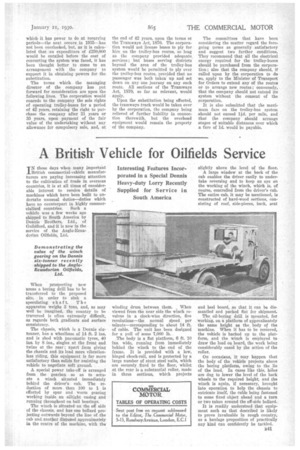A British Vehicle for Oilfields Service
Page 67

If you've noticed an error in this article please click here to report it so we can fix it.
TN these days when many important 'British. commercial-vehicle manufacturers are paying increasing attention to the cultivation of trade in overseas countries, it is at all times of considerable interest to receive details of machines which have been built to undertake unusual duties—duties which have no counterpart in highly commer cialized countries. Such a vehicle was a few weeks ago shipped to South America by Dennis Brothers, Ltd., of Guildford, and it is now in the service of the Anglo-Ecuadorian Oilfields, Ltd.
When prospecting new areas a boring drill has to be transferred to the proposed site, in order to sink a speculating shaft, The apparatus weighs 3 tons, and, as may well be imagined, the country to be traversed is often extremely difficult, as regards both gradients and surface consistency.
The chassis, which is a Dennis sixtonner, has a wheelbase of 14 ft. 2 ins, and is shod with pneumatic tyres, 40 ins. by 8 ins., singles at the front and twins at the rear; apart from giving the chassis and its load more vibrationless riding, this equipment is far more satisfactory than solids for assisting the vehicle to negotiate soft ground.
A special power take-off is arranged from the gearbox so as to actuate a winch situated immediately behind the driver's cab. The •reduction of more than 100 to 1 is effected by spur and worm gearing working inside an oiltight casing and running throughout on ball hearings.
The winch is situated on the off side of the chassis, and has one bollard projecting outwards beyond the lino of the cab and.another disposed approximately in the centre of the machine, with tho
winding drum between them. When viewed from the near side the winch revolves in a clock-wise direction, five revolutiOns—the normal Sneed per minute—corresponding to about 14 ft. of cable. The unit has been designed for a pull of some 7,000 lb.
The body is a flat platform, 6 ft. 10 ins, wide, running from immediately behind the winch to the end of the frame. It is provided with a low, hinged chock-rail, and is protected by a large number of stout steel nails, which are securely fixed to the floor, whilst at the rear is a substantial roller, made in three sections, which projects slightly above the level of the floor.
A large window at the back of the cab enables the driver easily to undertake reversing and to keep an eye on the working of the winch, which is, of coarse, controlled from the driver's cab. The entire cab, it may be mentioned, is constructed of hard-wood sections, consisting of roof, side-pieces, back, seat and heel board, so that it can be dismantled and packed flat for shipment.
The oil-boring drill is mounted, for working, on a platform of approximately the same height as the body or the machine. When it has to be removed, the vehicle is backed up to the platform, and the winch is employed to draw the load on board, the work being considerably eased by the action of the roller.
On occasions, it may happen that the body of the vehicle projects above the boring platform, owing to the lie of the land. In cases like this, hales are dug to lower the level of the back wheels to the required height, and the winch is again, if necessary, brought into operation to help the chassis to extricate itself, the cable being fastened to some fixed object ahead and a turn or two taken around the off-side bollard.
It is readily understood that equipment such as that described is likely to prove invaluable in rough country, as a haulage proposition of practically any kind can confidently be tackled.




















































































































